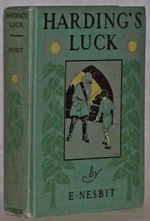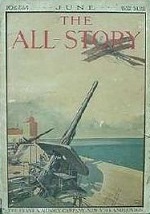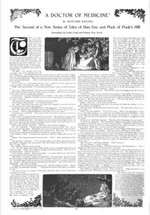|  | | | | 

| | Fabian Time Fantasies #2
Harding’s Luck
by E. Nesbit
First publication: The Strand, Jan–Nov 1909

Lame and orphaned Dickie Harding has just fallen in with thieves when he’s first taken in by a kind woman (with a pony) and then wakes up in the time of James the First, where he does have some minor encounters with Edred and his sister from The House of Arden. But those encounters aren’t the real story. The real story is that in the past he’s definitely livin’ the life as some sort of royalty, not even lame! How’s he to decide which era to live in? He was very happy. There seemed somehow to be more room in this new life than in the old one, and more time. No one was in a hurry, and there was not another house within a quarter of a mile. All green fields. Also he was a person of consequence. The servants called him “Master Richard,” and he felt, as he heard them, that being called Master Richard meant not only that the servants respected him as their master’s son, but that he was somebody from whom great things were expected. That he had duties of kindness and protection to the servants; that he was expected to grow up brave and noble and generous and unselfish, to care for those who called him master. He felt now very fully, what he had felt vaguely and dimly at Talbot Court, that he was not the sort of person who ought to do anything mean and dishonorable, such as being a burglar, and climbing in at pantry windows; that when he grew up he would be expected to look after his servants and laborers, and all the men and women whom he would have under him—that their happiness and well-being would be his charge. And the thought swelled his heart, and it seemed that he was born to a great destiny. He—little lame Dickie Harding of Deptford—he would hold these people’s lives in his hand. Well, he knew what poor people wanted; he had been poor—or he had dreamed that he was poor—it was all the same. Dreams and real life were so very much alike. He was very happy. There seemed somehow to be more room in this new life than in the old one, and more time. No one was in a hurry, and there was not another house within a quarter of a mile. All green fields. Also he was a person of consequence. The servants called him “Master Richard,” and he felt, as he heard them, that being called Master Richard meant not only that the servants respected him as their master’s son, but that he was somebody from whom great things were expected. That he had duties of kindness and protection to the servants; that he was expected to grow up brave and noble and generous and unselfish, to care for those who called him master. He felt now very fully, what he had felt vaguely and dimly at Talbot Court, that he was not the sort of person who ought to do anything mean and dishonorable, such as being a burglar, and climbing in at pantry windows; that when he grew up he would be expected to look after his servants and laborers, and all the men and women whom he would have under him—that their happiness and well-being would be his charge. And the thought swelled his heart, and it seemed that he was born to a great destiny. He—little lame Dickie Harding of Deptford—he would hold these people’s lives in his hand. Well, he knew what poor people wanted; he had been poor—or he had dreamed that he was poor—it was all the same. Dreams and real life were so very much alike. 
| |
| | | | |

 | | | |  | | “My Time Annihilator”
by George Allan England
First publication: All-Story, Jun 1909

 The narrator tells of a machine he built that will fly faster than the rotation of the earth and thus, by flying against the earth’s rotation, will travel backward in time. The narrator tells of a machine he built that will fly faster than the rotation of the earth and thus, by flying against the earth’s rotation, will travel backward in time. The next of a series, interspersed of course with many “normal” stories, so to speak, was “My Time Annihilator,” something along the lines of H.G. Wells’ “Time-Machine,”—which, by the way, I had not at that time read. Wells is, of course, one of the most successful modern “science-fakers.” The skill wherewith he makes the impossible seem possible may well serve as a model for any aspirants in this line of endeavor. The next of a series, interspersed of course with many “normal” stories, so to speak, was “My Time Annihilator,” something along the lines of H.G. Wells’ “Time-Machine,”—which, by the way, I had not at that time read. Wells is, of course, one of the most successful modern “science-fakers.” The skill wherewith he makes the impossible seem possible may well serve as a model for any aspirants in this line of endeavor. 

—George Allan England, “The Fantastic in Fiction: The Why and How of Making the Impossible Seem Possible” in The Story World and Photodramatist, Jul 1923
| |
| | | | |

 | | | | 

| | Rewards and Fairies
by Rudyard Kipling
First time travel: The Delineator, Oct 1906 (“A Doctor of Medicine”)

Rewards and Fairies is the second Kipling collection of stories about the the elf Puck and the people he magicked from the past to tell tales of history to the young twins, Dan and Una. The book appeared in 1910, but the stories themselves began in the September 1909 issue of The Delineator and the time travelin’ commenced with the arrival of the 17th-century astrologer/herbalist/plague-curer Nicholas Culpeper. The online scans of The Delineator are almost as much fun to read for the Ivory Soap ads as they are for Kipling. - “Cold Iron”, The Delineator, Sep 1909
- “Gloriana”, The Delineator, Dec 1909
- “The Wrong Thing”, The Delineator, Nov 1909
- “Marklake Witches”, Rewards and Fairies, Oct 1910
- “The Knife and the Naked Chalk”, Harper’s, Dec 1909
- “Brother Square-Toes”, The Delineator, Jul 1910
- “‘A Priest in Spite of Himself’”, The Delineator, Aug 1910
- “The Conversation of St. Wilfrid”, The Delineator, Jan 1910
- “A Doctor of Medicine”, The Delineator, Oct 1909
- “Simple Simon”, The Delineator, Jun 1910
- “The Tree of Justice”, The Delineator, Feb 1910
 ‘Ah – well! There have been worse men that Nick Culpeper to take lessons from. Now, where can we sit that’s not indoors?’ ‘Ah – well! There have been worse men that Nick Culpeper to take lessons from. Now, where can we sit that’s not indoors?’
 ‘In the hay-mow, next to old Middenboro,’ Dan suggested. ‘He doesn’t mind.’ ‘In the hay-mow, next to old Middenboro,’ Dan suggested. ‘He doesn’t mind.’ 

—“A Doctor of Medicine”
| |
| | | | |

No Time Travel. Move along. |
“Entrance and Exit” by Algernon Blackwood, The Westminster Gazette, 13 Feb 1909 [people-trapping dimensions ]

| |     |